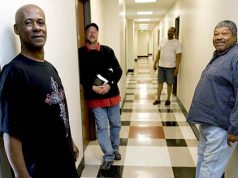
Mr. Trump, Tear Down This Wall
Written By: Jeffrey Goldberg
Editor in Chief of The Atlantic
Do not say that Donald Trump failed to build his wall. He built it. But he built it in Washington, D.C., not along the southern border, and he built it to shield himself from his fellow citizens, not to shield his fellow citizens from the existential threat posed by Mexican job-seekers.
The White House today is hidden behind a welter of barricades, anti-scale fencing, bollards, and Jersey barriers. The tens of thousands of people who flooded downtown D.C. in a celebratory release of pent-up anti-Trump feeling this weekend could barely see the people’s house. Lafayette Square, the scene of one of Trump’s most vulgar assaults on core American values, is now impenetrable. The White House fortress is a physical manifestation of Trump’s loathing for transparency and accountability, and it should be undone. The decent thing for Trump to do—though he seldom declines an opportunity to do the indecent thing—would be to disassemble this crude obstacle course before he leaves Washington for good.
Most presidents have taken seriously the idea of the White House as the “ people’s house.” Most have not gone as far as Andrew Jackson (a hero of Trump’s), who let a mob of his supporters overrun the house on Inauguration Day (something Trump would never do, given the way he actually feels about his supporters), but most presidents understand the nature of their tenancy. The house is meant to be the home of a citizen chosen by other citizens to lead the executive branch for a finite period. It is definitively not meant to be a palace.
Like many reporters who have worked—either periodically or daily—at the White House, my view of the place borders on mystical. (My feelings about the men who have occupied the Oval Office are generally not so gauzy.) The White House, like the Capitol and the Supreme Court, represents high ideals made manifest. These buildings should not be hidden. It’s the role of the current occupant of the White House to make sure that it is as accessible—or at least as visible—as possible.
This is not a complaint about security. I’ve visited the White House as a reporter since the days when cars were allowed to drive right by it. The decision to close Pennsylvania Avenue to traffic in 1995 was controversial, but it made sense, after the Oklahoma City bombing, as did the imposition of additional security measures following the terrorist attacks of 9/11. The ban had an upside, though: Freeing Pennsylvania Avenue of cars opened it to people. On sunny days, hundreds, even thousands, of visitors would take in the grandeur of the White House from just outside its fence.
Of course, would-be jumpers saw the wrought-iron fence as a temptation; in 2014, one made it over and into the building itself. At that point, the Secret Service and the National Park Service began planning for a new White House fence that would be twice as tall, replacing the ugly array of improvised barricades. Six years later, that new fence remains under construction.
The goal of a new fence was to make the White House safe, and visible. But Trump turned the White House into his own personal Green Zone. Fear has shaped both his message and his behavior over the past four years. Trump displayed nearly as much disrespect for the White House as he did for the presidency itself.
I have not visited the White House much during this presidency, particularly after this magazine published a cover story in early 2019 calling for Trump’s impeachment. One of my last visits came in May of 2018, for lunch with Jared Kushner, the president’s son-in-law and majordomo. The main topic of conversation was the Middle East, but as I was leaving, I registered my unhappiness with something egregious his father-in-law had just said (I have no recollection of the details, given the quantity and velocity of insults emanating from this White House). Kushner smiled and said, “No one can go as low as the president. You shouldn’t even try.” It took me a beat to realize that he meant this as a compliment to Trump, not as a criticism.
In the hours after the race was called for Joe Biden, the streets surrounding the White House were filled with relieved people, angry people, vengeful people, happy people, and happily vengeful people. What united everyone was a desire to have their house back.
Trump should tear down the walls around the White House. If he doesn’t, though, I don’t have much doubt that Joe Biden will.












